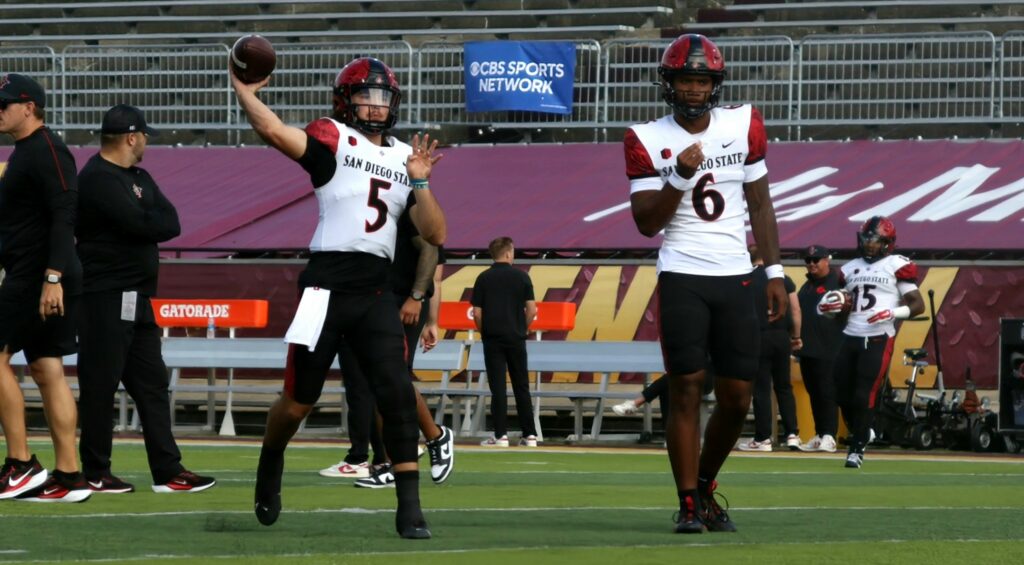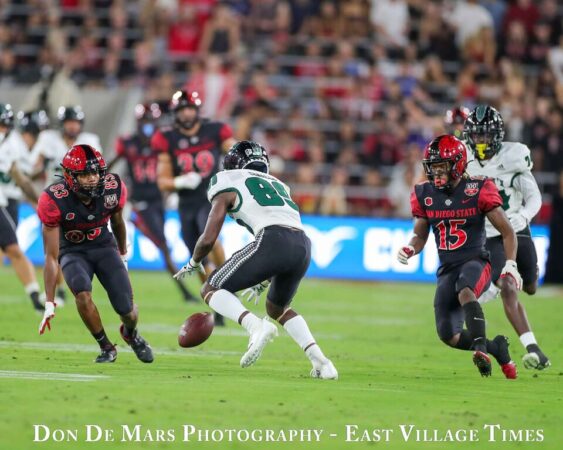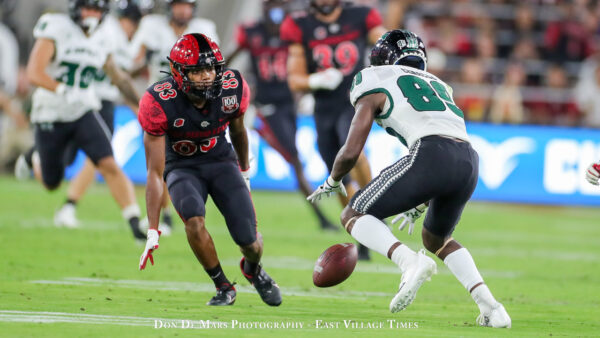San Diego State vs. Hawai’i: Ten Things to Watch

Danny O'Neil and Javance Tupou’ata-Johnson have left SDSU via the transfer portal. (Paul Garrison/EVT)

San Diego State’s football season is at a crossroads.
This offseason, the Aztecs added 44 new scholarship athletes. That total ranks sixth in the country behind North Texas (54), Colorado (49), Arizona State (49), Indiana (49), and Troy (49). To date, the strategy has worked much better at the other institutions than at SDSU.
Indiana is undefeated at 5-0. North Texas, Colorado, and Arizona State have one loss each. Only Troy (1-5) has produced results similar to those of the Aztecs.
Before the year, reading the intention of the turnover was challenging. SDSU has the fifth-fewest players in their final year of eligibility, suggesting the additions amounted to a rebuild. On the other hand, many of the 14 seniors on the team in their final college season fill significant roles in the two-deep, lending to the idea that head coach Sean Lewis aimed to retool his team to win in 2024.
Whatever the hoped-for outcome, Saturday’s contest against Hawai’i will reveal the roster makeover’s meaning. A loss to the Rainbow Warriors would change the outlook for the rest of 2024. Victory over Hawai’i in the Aztecs’ first conference game of the year would keep hope alive.
Below are ten storylines to follow.
10. Sean Lewis, game-manager
As gut-wrenching as the loss to Central Michigan was Lewis’s management of the game was promising. Every team enters a contest with its preferred approach. Last Saturday went according to the Chippewas’ script.
CMU mirrored Oregon State and Cal’s strategy. They wore the Aztecs down by winning the time of possession battle. They would have succeeded even more, except Lewis adjusted. He shelved Aztec Fast.
With 13:21 left in the third quarter, CMU took possession of the ball down 21-13. Fifteen plays and 7:29 of game time later, they scored a touchdown. Faced with an exhausted defense, Lewis was loyal to winning and took the air out of the ball.
Over the final 20 minutes of the game, the Aztecs went on two drives that ate up a combined 9:06 of the clock. SDSU did not win because of a pair of missed field goals, but in the coming years, altering the team’s approach based on what takes place in a game will lead to more victories.
This offseason, Lewis pointed to game management as a place where he has grown as a head coach. Last weekend was the first time this quality was on display. Studying the variety of ways he pursues victories is a storyline to follow. Consistent winning involves more than imposing your will on the opposition.

9. FBS Blues
SDSU and Hawaii are 3-0 this season against FCS competition and 0-5 against FBS teams. Each squad dominated the contests against the lower-tiered schools, had a close loss against an FBS program, and had at least one lopsided result against the top-level institutions. The trend will end on Saturday as someone will walk away from Snapdragon Stadium with an FBS victory.
Evaluating Hawaii is challenging because they played UCLA close (16-13) but lost to Sam Houston State in a blowout. The win over Hawai’i is the Bruins’ only one this year. The Bearkats are 4-1.
Hawai’i is undersized up front on defense. Their starting four on the line averages 265 pounds, including Ezra Evaimalo, who plays defensive tackle at 260. Noah Kema is the largest linebacker in the two-deep. He is listed at 225 lbs. The rest average 217.
Only Sam Houston State has exploited the Rainbow Warriors’ lack of size. They rushed the ball 47 times while attempting just 23 passes. UCLA threw 38 times and ran 20. SDSU featured balance until last week. Will they test Hawai’i’s small front?
SDSU’s defense has not faced a team as dedicated to the pass as Hawaii. Every opponent before Central Michigan ran the ball more than it passed. CMU had 46 passing attempts and 42 rushes. The Rainbow Warriors have had nearly a two-to-one pass-to-run ratio in the past three contests. They looked great against their FCS opponents and average against the FBS.
8. Welcome to Paradise
Two weeks before the Soviet Union initiated the Winter War by invading Finland in 1939, SDSU and Hawai’i began their football rivalry. UH won the initial contest at San Diego Stadium, 13-10. The Rainbow Warriors would have to wait for its next mainland victory over the Aztecs.
After playing in 1940, 1950, 51, and 53, the series took a break until 1980. UH joined the WAC in 1979, and the two squads faced each other every season from 1980 to 1998. During that stretch, Hawai’i took down SDSU at Jack Murphy Stadium twice, in 1981 and 1988.
Following a pair of non-conference contests on the island in 2002 and 2005, the teams linked up again as conference mates, this time in the Mountain West in 2012. Saturday will be the thirteenth straight year SDSU and UH have played. Only once in that span did the Aztecs fall when playing in America’s Finest City.
Hawai’i is 4-12 all-time in San Diego. Mission Valley is not the only place they have struggled. The Rainbow Warriors last had a winning road record in 2010. Since that year, they are 17-60 away from Honolulu and 48-43 at home.
Hawai’i’s lone lopsided defeat this year came at Sam Houston State.

7. New game plan?
Hawai’i’s total net yards each year against SDSU since 2012 are as follows: 173, 355, 264, 251, 215, 195, 516, 347, 272, 227, 196, 480. Aside from 2018 and 2023, the Aztecs defense has dominated UH.
In the last 12 years, UH has averaged 291 yards when it plays the Red and Black. Past results are not predictive but point to the talent gap between the two programs. SDSU has controlled the series by dictating the style of play.
Rocky Long and Brady Hoke led SDSU to a 10-2 series record during this span. They attacked Hawai’i’s spread offense with a potent rushing attack. The Aztecs won time of possession in ten contests and held UH to 14 points or less nine times.
Can SDSU continue winning in the series under Sean Lewis without copying Long and Hoke’s approach? Even on the few occasions when the Aztecs were unsuccessful in instituting their game plan against UH, everyone following them knew what their strategy approach would be.
Forty or fifty rushes with a handful of throws sprinkled in was the recipe for success for the Aztecs. SDSU attempted more passes than handoffs in just two of the games in the past 12 years. Ironically, those were the Red and Black’s two lowest-scoring contests during that period. They were 1-1 in those games.
What the strategy will look like on Saturday is anyone’s guess.
6. Close victory
Speaking about SDSU’s 10-2 record since UH joined the Mountain West might not be the most accurate data to mention. It certainly does not paint the complete picture.
As most teams do when they ascend to a better conference, Hawai’i had trouble in its first half-dozen Mountain West years. In that time, UH’s best record was 7-7. They achieved that mark in 2016 after earning a Hawai’i Bowl bid with a 6-7 regular season. Only one of its six contests with SDSU from 2012-2017 was decided by fewer than eight points.
UH’s fortunes changed once it figured out what it needed to compete in its new home. It has had a winning record in three of the past six seasons. As the Rainbow Warriors improved, they closed the gap with the Aztecs.
Seven points or less have decided five of the last six meetings. In 2018 and 2019, UH won by a combined four points. SDSU’s victories in the last three seasons have been by seven, two, and seven, respectively.
Only during the shortened COVID season was the margin of victory exaggerated. In 2020, the Aztecs won 34-10 in Carson.
Oddsmakers predict another close contest. SDSU is a 2.5-point favorite. If the game lives up to its billing, special teams will play an important role. Hawai’i’s Kansei Matsuzawa leads the team in scoring with 23 points. He is 4-5 on field goals this year and has converted all 11 extra points.

5. Will the Trey White tour continue?
Trey White has made an early case as the best pass rusher in the Mountain West. He has as many or more sacks as over half the teams in the conference. Air Force (4), Utah State (4), Colorado State (5), Nevada (5), and Wyoming (5) are among the 24 FBS teams with fewer QB takedowns than SDSU’s team captain. Fresno State and New Mexico have matched White’s total.
The local product’s exploits have entered rarified status, and he will impact Saturday’s game before it starts. He is competing at a level that Hawai’i will have to game plan to stop him. They will not have complete freedom in their designs. White is a constraint they must account for.
The Rainbow Warriors have given up eight sacks on the year. As with most of their stats, there is a significant split between FCS and FBS opponents. UCLA and Sam Houston State accounted for seven of them. The Bruins had five against Hawaii. Amazingly, those are UCLA’s only sacks of the season.
Two of the eight players, Sam Houston State’s Briceon Hayes and Chis Murray, have a physical profile similar to White’s. The rest are defensive tackles, linebackers, and defensive backs.
Watching how White responds to double teams is a storyline to follow. Learning how his teammates take advantage of the attention given to him is another.
4. Secondary Test
Saturday represents SDSU’s secondary’s stiffest test. Hawai’i ranks no. 38 in the country, averaging 265.2 passing yards per game. CAL and Central Michigan ran more against the Aztecs than their other opponents. It is doubtful the Rainbow Warriors will be able to run effectively enough to modify their playing style.
UH is one of two teams in the nation that has yet to rush 100 times during the season. At first glance, their 96 yards per game average would suggest potency on the ground. But, against FBS opponents, they average only 2.2 yards per carry and 53.5 yards each game.
Star QB Brayden Schager leads Hawai’i with 34 carries. His scrambles suggest the official run/pass ratio does not reflect how often head coach Timmy Chang calls passes. Chang gave two consecutive carries to his running backs just five times in 23 drives against FBS opponents.
Schager has a stable of terrific receivers that will test the Aztecs secondary. 6-foot-2 wideout Pofele Ashlock leads them. Unlike his team, Ashlock’s best games have come against FBS opponents. He had 112 yards against UCLA and 84 versus Sam Houston State. He has scored a touchdown in the past three contests.

3. Explosive Plays
Saturday will likely come down to which team can create the most explosive plays. SDSU has yet to put together a touchdown drive without at least one play greater than 20 yards.
Against Central Michigan last week, a deep pass to Louis Brown IV, a long run by Marquez Cooper, and a turnover set up three touchdowns. Jordan Napier’s 40-yard catch and run was SDSU’s only touchdown against Cal. Cooper and Brown scored on big gains against Texas A&M-Commerce. The other times SDSU hit paydirt on offense, it was set up by a 29-yard pass to Napier and Danny O’Neil’s 28-yard scamper.
Hawai’i has had 13 explosive plays this year, with four going for touchdowns. Eleven passes have gone for 20 or more yards, the Rainbow Warriors have one rush for 29 yards, and they returned a punt 44 yards.
Wide receiver Dekel Crowdus is a player to watch for the Rainbow Warriors. He caught a 59-yard pass against Northern Iowa, a 52-yarder against Sam Houston State, and a 29-yard completion against Delaware State. Crowdus is no. 18 in the country with a 21.44 yards per reception average.
Crowdus is not alone in creating explosive plays. Four other receivers have made huge gains. Running back Landin Sims has a 22-yard reception and a 29-yard run.
2. Turning Danny O’Neil loose
Marquez Cooper has been the focal point of SDSU’s offense this season. Lewis pulled a page out of his predecessor’s playbook last week by rushing 22 more times than he passed. The tactic put SDSU in a position to win, but overall, Lewis’ offense has yet to play well against an FBS opponent.
Expect Hawai’i to copy what every team on the Aztecs’ schedule has done and try to make SDSU one-dimensional by keying on Cooper. Texas A&M-Commerce did not have the athletes to stop Cooper. Oregon State, Cal, and Central Michigan did.
Hawai’i ranks no. 57 against the rush. Are their numbers skewed by games against a pair of FCS opponents and the team with the fewest rushing attempts in the country?
There are many paths to victory. SDSU’s typical game plan against Hawai’i would likely produce a win on Saturday. Another would be to allow Danny O’Neil to carry the offense. O’Neil threw for 246 yards on only 23 attempts against the Chippewas.
In many ways, last week’s contest was similar to SDSU’s past under Hoke and Long. Central Michigan was geared to stop the run, daring the Aztecs to throw the ball. Unlike many of his predecessors, O’Neil took advantage. He ranks no. 66 in the nation with 12.06 yards per completion. Last week, SDSU’s signal caller averaged 17.6 yards per completion. Auburn’s Payton Thorne leads the country with a 17.02 average.
O’Neil’s knee injury and average athleticism will prevent SDSU from unlocking Cooper using the read/option. The other path to attaining balance on offense is to throw the ball more. Lewis has asked O’Neil to be a game manager to date. The true freshman has done well in the role. He has yet to throw an interception, orchestrates the screen game effectively, and is improving at throwing the deep ball.
Saturday could be the time to put more on O’Neil’s shoulders.
1. 80 plays
On Saturday, Lewis’ advertisement of Aztec Fast will likely be shown on big screens at Snapdragon Stadium. Lewis will claim that SDSU will play “as fast as humanly possible.” Number of snaps is the typical measure of pace of play. This season, the Aztecs are similar to last year.
SDSU’s 73 plays against TAMCU are the highest to date. It was the only time SDSU reached 70, something the Aztecs did three times in 2023, including 79 in the last contest of the year. The Red and Black’s 49 snaps for 179 total yards against Oregon State was lower than the abysmal 2023 performances against Air Force (55 snaps/227 yards) and Nevada (53/204).
Lewis’ offense averages 63.8 plays per game in 2024. The Aztecs averaged 64.4 last year.
Brayden Schager completed 81.4% of his passes last week. Before that, he completed 50% against Delaware State and Sam Houston State while finding receivers on 59.5% of his throws against UCLA. If Schager passes closer to how he did in the season’s first three weeks, the clock will stop frequently, allowing the Aztecs more opportunities.
Seeing if the Aztecs can cross the 80-play threshold on Saturday is something to watch.
My earliest sport’s memory involve tailgating at the Murph, running down the circular exit ramps, and seeing the Padres, Chargers and Aztecs play. As a second generation Aztec, I am passionate about all things SDSU. Other interests include raising my four children, being a great husband and teaching high school.